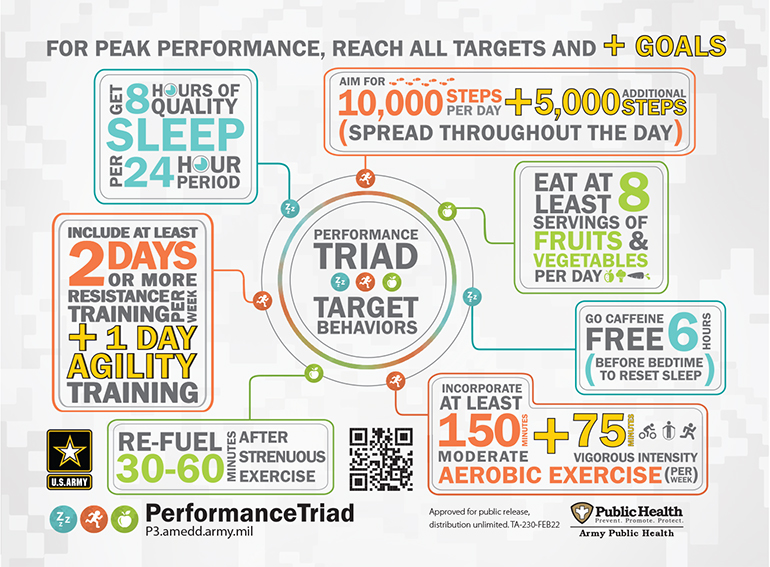Miriam Rodriguez
WSMR Public Affairs

Due to the increased demand in real world support requirements to enable the on-going battle against the Covid-19 pandemic, the 2022 Bataan Memorial Death March will be a virtual only event March 20-27. To register for the virtual event, go to Bataanmarch.com.
Tips for Preparing for Bataan Memorial Death March
Although the Bataan Memorial Death March will be a virtual event this year, it is still important that participants train properly.
Due to the increased demand in real world support requirements to enable the on-going battle against the Covid-19 pandemic, the 2022 Bataan Memorial Death March will be a virtual only event March 20-27. To register for the virtual event, go to Bataanmarch.com.
McAfee U.S. Army Health Clinic Commander Lt. Col. Marc Skinner said he is a big fan of sports specific training.
“The SAID principle (specific adaptations to imposed demands) states the things that you do are what the body will adapt to get better at,” Skinner said. “So, in the case of Bataan, you have the heavy division and light division, with gear and without gear, and you just have to look at what division you are going to participate in and then you need to train to that.”
Skinner said the U.S. Army teaches that there is a point of diminishing return, when looking at performance improvement versus a risk for chronic or overuse injuries.
The point of diminishing returns refers to a point after the optimal level of capacity is reached, where every added unit of production results in a smaller increase in output.
“If you overdo it your risk for injuries can double or triple. Your risk for injury increases,” Skinner said.
So, that means that for people who don’t usually do marathons or long distance endurance events, the Bataan Memorial Death March is considered a relatively novel task that they will be training for.
“Limiting impact based activities, running or walking, with an external load applied, you probably are going to want to keep it to a maximum of 3 days of training per week, so that the body has adequate time to recover between sessions,” Skinner said.
The U.S. Army has the performance triad – physical activity, sleep and nutrition.
“It all comes down to those three things. You can’t get in the pool and go for a swim and think that is going to improve your ability to run long distances or walk long distances under an external load like a 35-pound ruck sack. It is just not going to happen,” Skinner said.
Skinner said that may help with some other improvements, but it is not going to translate to an improvement in the task that you want to do – like running or walking in the Bataan Memorial Death March.
“When you go out and you are being physically active training for an event you are not actually getting stronger, faster, better at that point – you are actually breaking things down,” Skinner said.
“When you are actually getting stronger, faster, better, is during the recovery part of it, which is when you are sleeping,” Skinner said.
He said that if you are not giving yourself sufficient time to sleep, you are not giving yourself sufficient time to recover. So if you are just doing all this training and not eating properly or resting, you are potentially setting yourself up for either an acute or overuse injury because you are not giving your body the time it needs to recover.
Participants also need to ask themselves how are they refueling their bodies when it comes to nutrition.
“You have to make sure you are getting the right number of calories in the right ration of carbs, fat and protein,” Skinner said.
For elite level folks, Skinner said the timing of that nutrition is even more important.
“Making sure you are getting enough carbs and protein within the first 30 to 60 minutes after exercise, will really help fuel the recovery,” Skinner said.
“The other thing I would touch on for Bataan in particular, is that as folks are out there training, they need to be thinking about their refuel and hydration strategies in the race,” Skinner said. “So, if we look at marathons, folks run thru their glycogen, their energy stores, after about an hour, hour and a half of ongoing physical activity. So they need to be sure they are taking in some calories along the way.”
It is not a full meal. Skinner said some of the sports drinks out there have it figured out, where there is some sugar in the drink, and the type of sugar is important.
“If it is too much (of anything) it is going to slow you down. You are going to have cramps, gastro intestinal distress, things of that nature. So it is important that while you are training that you figure out what works for your body. That is pretty important to have a refuel strategy while you are training.”
“The number one thing people need to sort out is their hydration status.”
Skinner said that when you look at one of the main reasons folks are unable to complete Bataan, dehydration is usually the biggest thing. He said it comes down to inadequate hydration along the way.
“They are not taking in enough fluids to replenish what they are losing. It only takes a 1 percent change in loss of body weight from sweating during activity and even that little amount equates to a substantial decrease in physical performance. So maintaining adequate hydration is pretty important.”
Skinner said participants can also overdo it, which is why it is important to find out what your level is during training. You need to know how much fluid you need to take in that it keeps you running in optimal performance but that won’t have you running to the bathroom every five minutes either.
“So it is a bit of a balance act. And the only way to figure out what works for you is to train. While you are out training and preparing for Bataan make sure to incorporate a nutrition and hydration plan. That is very important.”
Skinner said there is a way to figure out what that number is for each individual.
Within the first hour it is just water. You don’t need additional calories in the first hour.
So if the activity is going to take you past the first hour, that is when you are going to need to take some calories.
“Again, if you take in too much, you can cause gastrointestinal distress. Your stomach is going to hurt. It can be as easy as some cramping or as bad as diarrhea, where you will have to stop and go to the bathroom. So you have to test out the different brands and flavors. You need to find what works for you and what you like or don’t like. And then you have to figure out the amount.”
For hydration status there are two things you can look at: One is a very bad indicator - if you are thirsty, it is too late.
“If you are already down the road of dehydration, thirst is a very bad indicator. The other thing you can look at is the color of your urine. If your urine is yellow or dark yellow, you are dehydrated. If it is a really light yellow to clear you are hydrated.”
According to Skinner, the best way to figure that balance out is to include it in your training.
Overall, Skinner said you have to get miles in and then slowly build up to the point where it would be more than an hours’ worth of cardio or endurance training so that you can then start to incorporate your nutrition and hydration refuel strategy.
“So you can have enough energy and enough fluids to keep things moving.”




